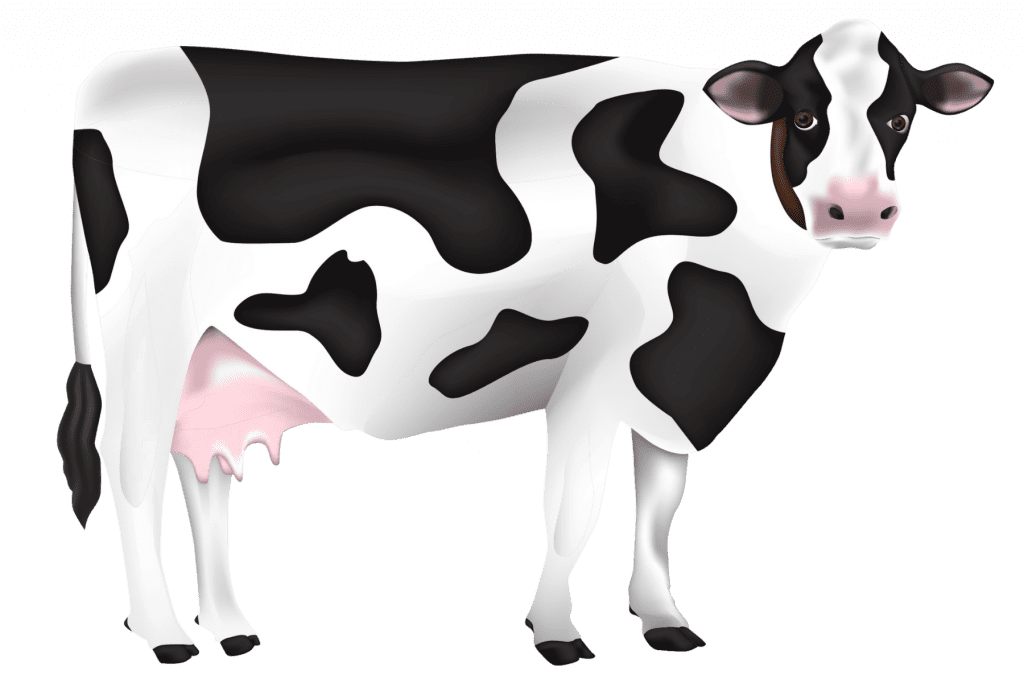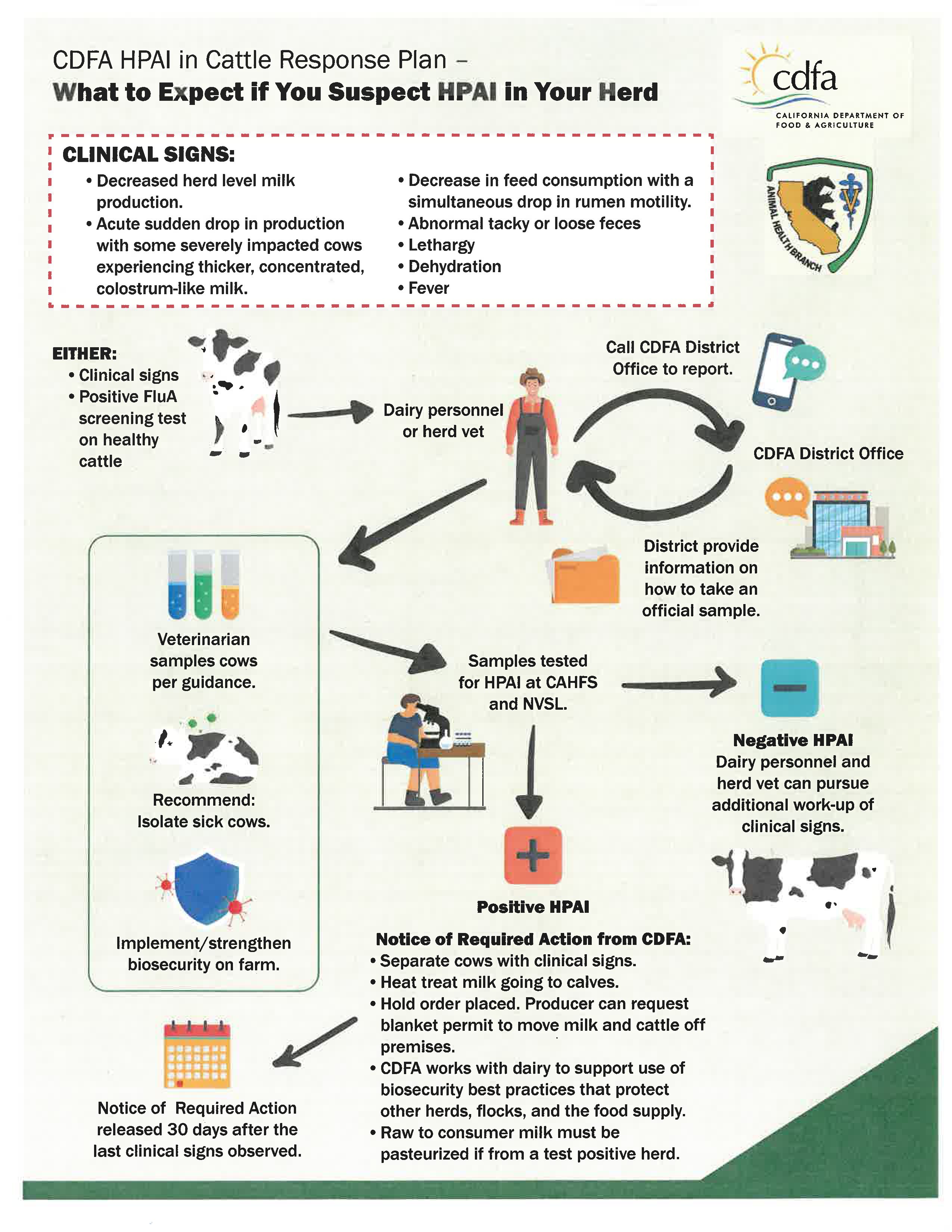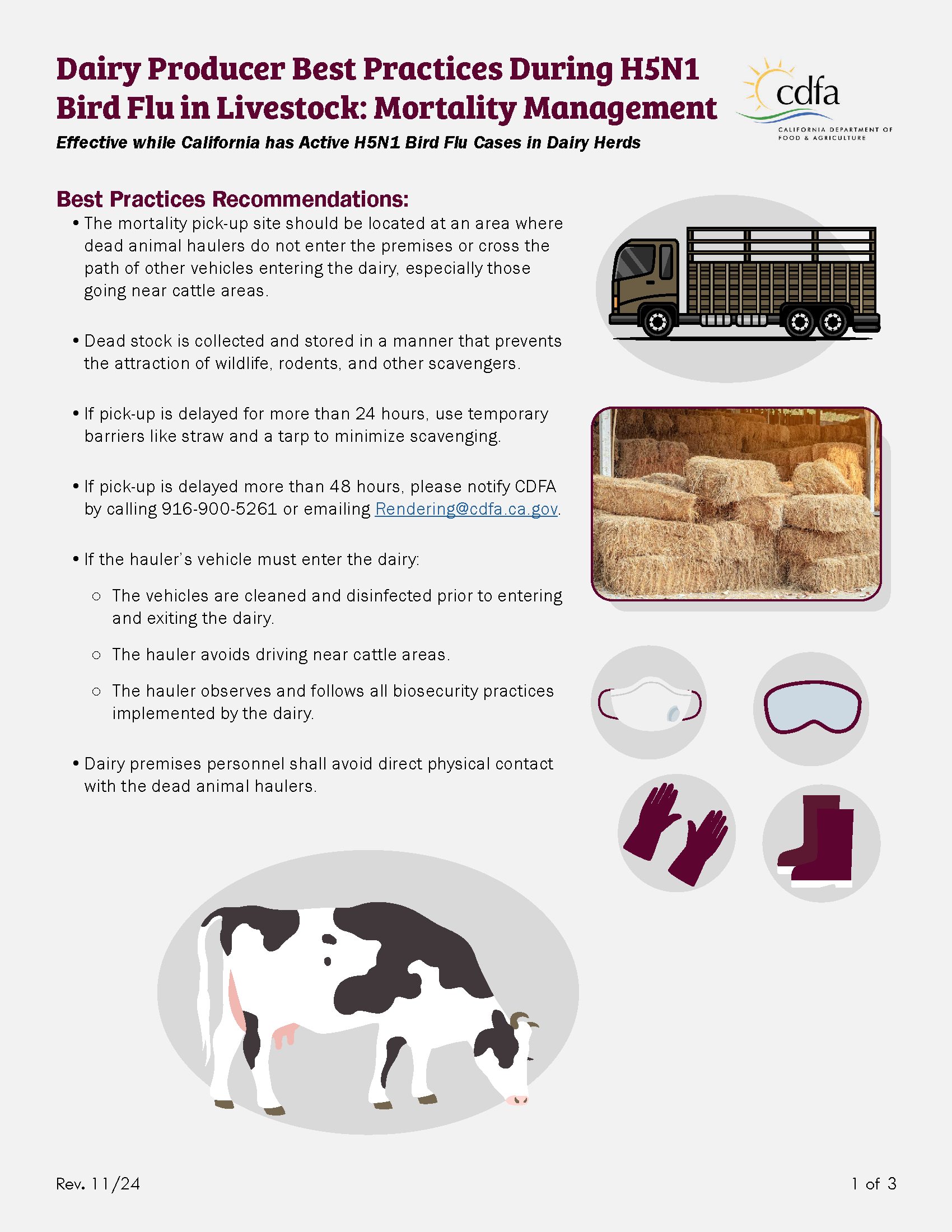Avian influenza is an influenza type A virus that occurs naturally in wild aquatic birds, including ducks, geese and gulls. Mild forms of avian influenza (known as low pathogenic avian influenza, or LPAI) are routinely found in wild birds and don’t cause serious illness. From time to time, a mild strain changes through mutation or mixing with other flu viruses into a more severe type of the virus (highly pathogenic avian influenza, or HPAI). HPAI historically has caused 75-100% mortality in poultry, like chickens and turkeys, as well as some wild birds. The current outbreak of HPAI has spread into dairy cattle, domestic cats, many species of wildlife and also a small number of people.
What should I do if I see a dead bird or suspect sick livestock?
If you find a dead bird, please report it to the California Department of Fish and Wildlife (CDFW) using the Wildlife Mortality Reporting Form.
Report Sick or Dead Domestic Birds: Sick and dead poultry, domestic ducks and pet birds may be reported to the California Department of Food and Agriculture’s (CDFA) hotline at (866) 922-2473.
Report Sick Livestock: Dairy personnel or herd veterinarian should call the CDFA District Office at (909) 947-5932 to report sick dairy cows.
IMPORTANT CONTACT INFORMATION
California Department of Food and Agriculture
- Website: https://www.cdfa.ca.gov/AHFSS/Animal_Health/HPAI.html
- Phone Number: If you suspect Bird Flu in your livestock, call 1-(866) 922-2473.
San Bernardino County Department of Public Health
- Website: https://dph.sbcounty.gov/birdflu/
- Phone Number: For more information, please contact the Communicable Disease Section (CDS) at (800) 722-4794 (8 a.m. – 5 p.m., Monday – Friday). After Hours Phone: (800) 472-2376 (available after hours, weekends, and holidays).
Signs of H5N1 Bird Flu
H5N1 a strain of the Highly Pathogenic Avian Influenza (HPAI) is a highly contagious and often deadly respiratory disease in poultry, such as chickens, turkeys, and geese. It is often spread by wild birds and can infect and make other animals such as livestock and other mammals sick too. The current strain of H5N1 avian influenza affecting our livestock is spreading across the country and state due to several factors.
The primary factor of viral spread is through movement of infected livestock. Transmission between farms is likely due to normal business operations including the movement of animals, contaminated vehicles, and other farm equipment frequently moving on and off affected premises and on to other premises.
Additionally, H5N1 avian influenza infected cattle can have an asymptomatic incubation period of about 3-10 days so, when infected cattle that look healthy are moved, non-infected cattle are exposed to the virus.
Clinical Signs
Clinical Signs Infected cattle may be asymptomatic (subclinical) or symptomatic (clinical) and virus is predominantly found in milk and mammary tissue regardless of symptoms.
Clinical signs may include:
- Decrease in feed consumption with a simultaneous decrease in rumination and rumen motility
- Respiratory signs including clear nasal discharge
- Acute drop in milk production. Severely affected cattle may have thicker, concentrated, colostrum-like milk or produce no milk at all.
- Abnormal tacky or loose feces
- Lethargy
- Dehydration
- Fever
Diagnosis & Prevention
There is currently no cure for animals infected with Bird Flu and there are currently no vaccines available to prevent this disease. Veterinarians and livestock owners who suspect an animal may have Bird Flu should immediately contact a State or Federal animal health authority.
Testing for H5N1 Avian Influenza in milk samples (lactating cattle) or nasal swab samples (non-lactating cattle) can confirm viral infections.
Even with the best defense measures, H5N1 Bird Flu can still affect your herd.
The following are ways to help protect livestock:
- No movement of clinical dairy cattle for 30 days past last matrix-A positive H5N1 test
- Ensure cattle trailers are only used to haul your cattle or thoroughly clean and disinfect trailers between use.
- Adhere to an isolation period of a minimum of 30 days for new arrivals with active observational surveillance for clinical signs.
- Feed only heat treated/pasteurized milk to calves and other livestock and heat treat/pasteurize any milk being discarded.
- Milk affected animals last with thorough cleaning and disinfection of milking equipment (utilizing dedicated milking units if possible)
- Separate animals with clinical signs from healthy animals
- Use dedicated coveralls and boots when handling clinical animals (use dedicated farm personnel to only handle clinical animals where possible).
- Use good personal hygiene measures including freshly laundered clothes and showering before visiting dairy farms or processing facilities.
- Limit vehicle/visitor traffic to strictly essential deliveries/visits (feed, milk, waste removal).
- Clean and disinfect vehicles crossing the line of separation and entering/leaving the farm or obtain a commercial car wash before and after visiting a livestock operation.
- Engage state and federal wildlife agencies for wild bird mitigation.
Sampling Protocol for H5N1 Avian Influenza in Livestock
- Protocol for cows with clinical signs of H5N1 Avian Influenza
a. For dairies with suspect clinical signs contact your district office for regulatory personnel to conduct a Foreign Animal Disease investigation (FADi). - Protocol for lactating dairy cattle moving interstate (not direct to slaughter movements)
a. All lactating dairy cattle moving interstate require a Certificate of Veterinary Inspection (CVI) and matrix-A negative H5N1 Avian Influenza test from a National Animal Health Laboratory Network (NALHN) laboratory within seven (7) days of movement.
b. Samples must be collected by an accredited veterinarian, a sample collector approved by a state animal health official, or a designated individual at a farm that was trained to collect milk and nasal swab samples.
c. The sample must be sent to an approved NAHLN laboratory (UC Davis California Animal Health and Food Safety (CAHFS) Laboratory is currently only approved laboratory in California)
d. For groups/lots of 30 or fewer animals moving interstate, all animals being moved must be tested. If more than 30 animals are moving interstate, only 30 animals total must be tested. - Protocol for non-lactating dairy cattle moving interstate and any dairy cattle moving interstate direct to slaughter:
a. Currently no testing required, must have CVI within seven (7) days of movement.
CDFA appreciates your efforts to protect livestock health in California on a daily basis. Remember, people, equipment, and vehicles can easily spread dangerous diseases from one location to another.
Why was the new outbreak in dairy cattle featured so heavily in the news?
Samples from a recent outbreak in dairy cattle in Nevada revealed the existence of two genetic types of HPAI viruses in dairy cattle. The one in Nevada is called genotype D1.1, and is different from the genetic type previously found in cattle in the United States (genotype B3.13).
This finding suggests that the outbreak in Nevada did not result from contact with an infected cow or contaminated farm equipment, but rather resulted from a new introduction into cattle from wild birds.
While this new genetic variation (genotype D1.1) does not in and of itself greatly change the risk to cattle or human health, it shows the risk of new introductions from birds into dairy operations. Repeated new introductions will make controlling the virus in dairy cattle more difficult, and highlights the need for strong testing/surveillance programs and concerted prevention efforts.


CDFA’s H5N1 Regional Strategy
Southern California > Limit Spread
- Dairy & Poultry Biosecurity: Technical assistance and proactive biosecurity support.
- Reduce Viral Load: Build disease buffers around dense dairy regions and maintain proactive testing of dairies and poultry.
- Movement Control: Reduce risk of moving virus within and out of the region.
- Event Restrictions: Postpone fairs and shows involving poultry or dairy.
- Continue epidemiological analysis and reporting.
- Support H5N1 research studies, including internal epidemiological risk analysis, and promote data sharing.
- Manage poultry cases in accordance with national standards.
- Support poultry biosecurity to mitigate wild bird risk AND risk from dairies, assuming every dairy poses a threat.
- Provide technical assistance as requested.
- Manage movement to reduce the risk of spreading the virus within and out of the region and minimize the threat that infected dairies pose to poultry operations.
- Feedlots and dairies are generally not geographically co-located, making movements to Imperial Valley feedlots less concerning.
- Focus on building buffer zones around dense dairy regions where possible.
- Manage calf movement off an IP through 85 days of age via quarantine biosecurity and traceability requirements IF they MAY be co-mingled with animals returning to dairy farms, particularly those out of region.
- Limit movement of lactating cows and springers from IPs via quarantine biosecurity, movement control, and traceability requirements – no intermingling with cattle that may not be going direct to slaughter or an IP.
- Manage dairy movement through markets to reduce potential spread by separating IP sales from unaffected sales, with IP sales restricted to slaughter-only cattle.
- Postpone fairs and shows that include dairy or poultry.
- Manage surveillance for uninfected dairies by testing conventional dairies every 2-4 weeks and raw milk dairies weekly until the State is disease-free. Transition to the national surveillance strategy thereafter.

